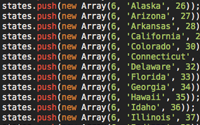Categories
- Active Record
- Active Resource
- Active Support
- Administration
- Ajax
- APIs
- Authentication
- Authorization
- Background Jobs
- Caching
- Code Walkthrough
- Controllers
- Debugging
- Deployment
- eCommerce
- Forms
- Mailing
- Models
- Performance
- Plugins
- Production
- Rack
- Rails 2.0
- Rails 2.1
- Rails 2.2
- Rails 2.3
- Rails 3.0
- Rails 3.1
- Rails 3.2
- Rails 4.0
- Refactoring
- Routing
- Search
- Security
- Testing
- Tools
- Views
Turbolinks
Turbolinks can make your Rails app feel faster by using JavaScript to replace the page content when clicking a link. It will be default in new Rails 4.0 applications, but here I show how to use it in Rails 3 and mention some of the gotchas.
(7 minutes)
Dynamic Page Caching (revised)
Page caching is great for speeding up the performance of a page, but what if it contains user-specific content? Learn how to load content in dynamically through JavaScript in this episode.
(7 minutes)
Client-Side Performance
Optimizing Rails performance can only take you so far. The client-side plays a big part in how fast a page feels. Here I show many tools that can help make your apps faster than ever.
(14 minutes)
Rails Modularity
Rails is a modular framework allowing you to include only what you need. Here I show how the smallest Rails app works, and then I take a look at how to whittle down a full Rails application stack.
(13 minutes)
Dynamic Page Caching
Use JavaScript to allow dynamic content in a page cache. In this episode I show you how to insert the user-specific content into a page through JavaScript.
(11 minutes)
Page Caching
Page caching is an efficient way to cache stateless content. In this episode I will show you how to cache the dynamic javascript we created last week.
(6 minutes)






